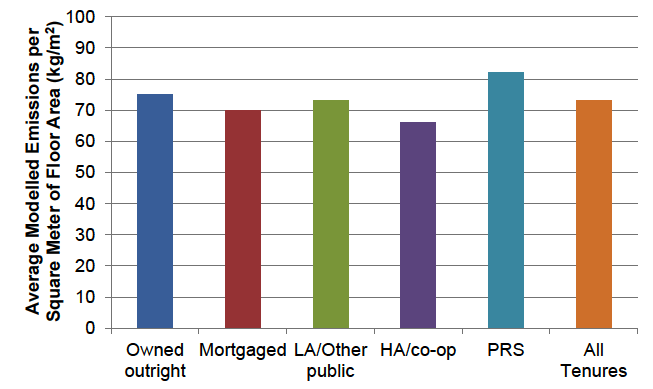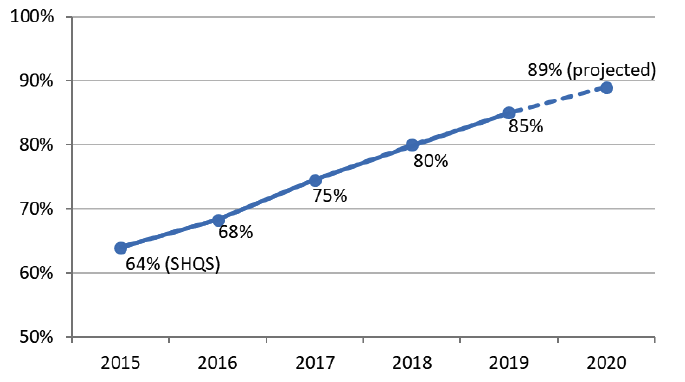Energy efficiency in social housing: guidance for landlords - revised 2020
Guidance for social landlords on the Energy Efficiency Standard for Social Housing (EESSH).
8 Costs and benefits of the EESSH
Benefits of delivering the EESSH
8.1 For tenants, attainment of the EESSH will mean that in the main no social property will be lower than a C or D band energy efficiency rating. Tenants should benefit from a warmer home, which could mean lower fuel consumption, lower energy bills and fewer tenants in fuel poverty. Attaining the EESSH, in addition to regulations specifying minimum energy efficiency of new boilers, is projected to provide benefits to social tenants of around £127m each year in reduced fuel bills due to improved energy efficiency. This is equivalent to an average of around £210 per year per household.
8.2 For climate change carbon abatement, attainment of the EESSH is projected to reduce carbon output by 760kT per annum from the social rented sector – equivalent to the combined annual household emissions of Aberdeen and Dundee. Based on modelled energy use, the average Scottish home is estimated to produce 6.8 tonnes of CO2 per year in 2018. Chart 1 shows the modelled average contribution of emissions from housing in different tenures.[23]

8.3 The estimates of the benefits of the EESSH were made during the development work for the Business Regulatory Impact Assessment and the EESSH case studies in 2014. Similar assessment has been undertaken as part of the development of the next EESSH milestone from 2020 onwards.[24]
Estimated costs of compliance with the EESSH
8.4 The Scottish Government worked with case study landlords to produce estimates of EESSH compliance rates and associated additional costs. The EESSH modelling showed that compliance with the SHQS would mean that 64% of social housing would already meet the relevant EESSH rating at 1 April 2015. It was estimated that a further £310m would be needed to achieve 88% compliance using only reasonable measures (made up of £166m for local authority housing and £144m for RSLs), and that a total of £892m would be needed to achieve 99% compliance with the EESSH (made up of £478m for local authorities and £415m for RSLs).
Actual costs in first two years of the EESSH
8.5 Tables 7a-b below collate data on investment from the performance returns made by social landlords to the Scottish Housing Regulator for the business years 2015/16 and 2018/19.[25]
Table 7a: Local Authorities' investment to bring properties up to the EESSH (£m)
| 2015/16 | 2016/17 | 2017/18 | 2018/19 | Total 2015-2019 | |
|---|---|---|---|---|---|
| Investment from subsidy | 6.15 | 11.12 | 6.18 | 7.17 | 30.63 |
| Investment from own resources | 64.37 | 49.29 | 71.33 | 70.54 | 255.53 |
| Investment from other sources | 0.95 | 1.17 | 0.90 | 0.05 | 3.07 |
| Total | 71.47 | 61.58 | 78.42 | 77.76 | 289.23 |
Table 7b: Registered Social Landlords' investment to bring properties up to the EESSH (£m)
| 2015/16 | 2016/17 | 2017/18 | 2018/19 | Total 2015-2019 | |
|---|---|---|---|---|---|
| Investment from subsidy | 11.61 | 4.86 | 1.74 | 2.06 | 20.27 |
| Investment from own resources | 28.05 | 30.41 | 34.33 | 24.80 | 117.59 |
| Investment from other sources | 0.72 | 3.05 | 1.96 | 2.31 | 8.04 |
| Total | 40.38 | 38.33 | 38.03 | 29.17 | 145.90 |
8.6 Table 8 summarises the performance data. This shows encouraging progress towards the EESSH target for 2020, but with reliance on landlords' own resources to achieve it.
Table 8: EESSH performance 2015/16 to 18/19
| 2015/16 | 2016/17 | 2017/18 | 2018/19 | |
|---|---|---|---|---|
| Social housing in scope of EESSH | 593,936 | 592,007 | 595,449 | 600,072 |
| Social housing meeting EESSH | 407,698 | 441,252 | 475,625 | 507,179 |
| EESSH compliance | 68.6% | 74.5% | 79.9% | 84.5% |
| Total investment in year | £112m | £100m | £116m | £107m |
| Investment from landlords' own resources | 82.6% | 79.8% | 90.7% | 89.2% |
| Number of homes improved in year | 18,666 | 25,777 | 28,979 | 32,119 |
| Average investment per home improved | £5,992 | £3,876 | £4,018 | £3,329 |
| Total anticipated exemptions to EESSH | 9,428 | 17,213 | 20,394 | 23,374 |
8.7 Chart 2 illustrates progress towards the 2020 target, including landlords' estimates of the houses that will be brought up to EESSH during 2019/20 (based on landlords' anticipated exemptions).

Contact
Email: josh.kumar@gov.scot
There is a problem
Thanks for your feedback